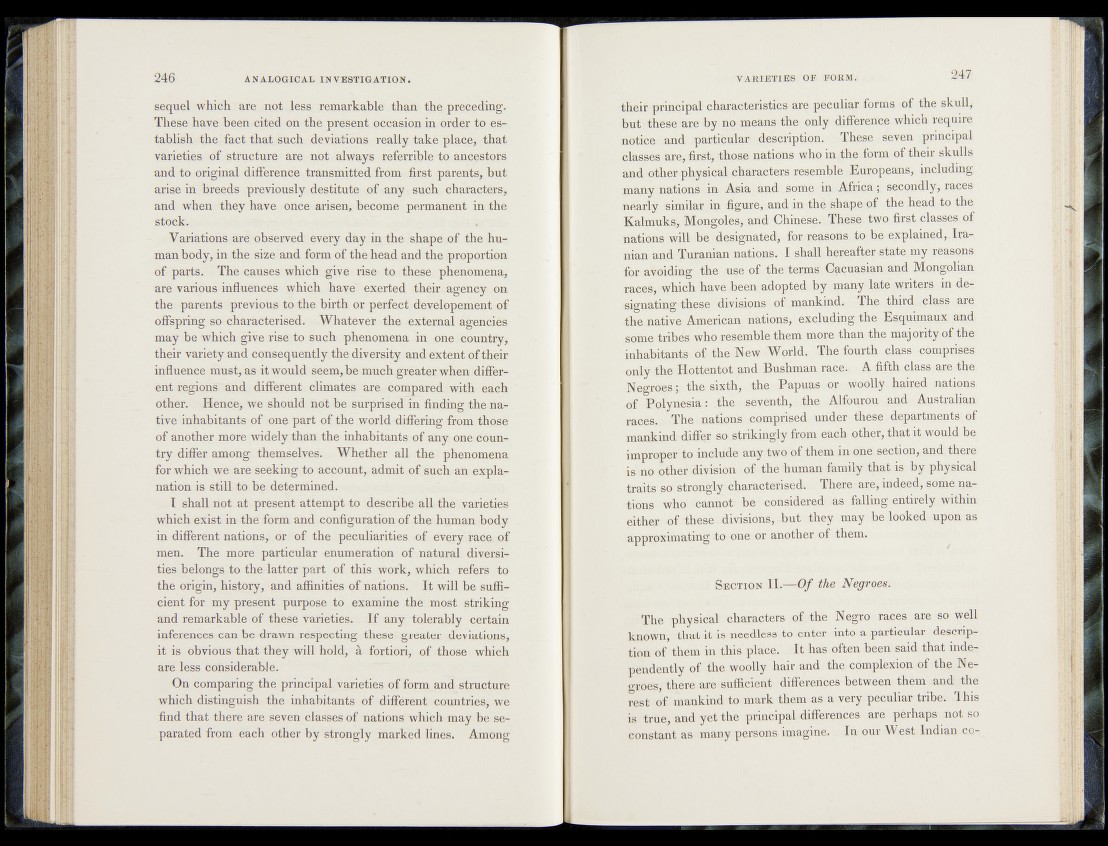
sequel which are not less remarkable than the preceding.
These have been cited on the present occasion in order to establish
the fact that such deviations really take place, that
varieties of structure are not always referriblp'to ancestors
and to original difference transmitted from first parents, but
arise in' breeds previously destitute of any such characters,
and when they have once arisen, become permanent in the
stock. - ,
Variations are observed every day in the shape of the human
body, in the size and form of the head and the proportion
of parts. The causes which give rise to these phenomena,
are various influences which have' exerted their agency on
the parents previous to the birth or perfect developement of
offspring so characterised. Whatever the external agencies
may be which give rise to such phenomena in one country,
their variety and consequently the diversity and extent oftheir
influence must, as it would seem, be much greater when different
regions and different climates are compared with each
other. Hence, we should not be surprised in finding the native
inhabitants of one part of the world differing from those
of another more widely than the inhabitants of any one country
differ among themselves. Whether all the phenomena
for which we are seeking to account, admit of such an explanation
is still to be determined.
I shall not at present attempt to describe a lt the varieties
which exist in the form and configuration of th e human body
in different nations, or of the peculiarities of every race, of
men. The more particular enumeration of natural diversities
belongs to the latter part of this work, which refers to
the origin, history, and affinities of nations. It will be sufficient
for my present purpose to examine the most striking
and remarkable of these varieties. I f any tolerably certain
inferences can be drawn respecting these greater deviations,
it is obvious that they will hold, à fortiori, of those which
are less considerable.
On comparing the principal varieties of form and structure
which distinguish the inhabitants o f different countries, we
find that there are seven classes of nations which may be separated
from each other by strongly .marked lines. Among
their principal characteristics are peculiar forms of the skull,
but * these are by nojmeans the only difference which require
notice and particular/, description. Theset*Steven principal
classes .are, first,; those nations who in^the form of their skulls
and other physical characters resemble « Europeans, including
many nations in Asia and^Oahje ’in Africa secondly, races
nearly similar in figure, and in thejshape- pf the head to «the
Kalmuks, Mongoj.es, and .Chinese^ These two first classesiof
nations will be designated, for reasoi^ffp»be'explained,,Iranian
and Turanian ^rations. I shall hereafter .state«,my reas^ns
for avoiding the use of «the terms C^cuasian and Mongolian*
races, which have been adop|gd b y imfny late writers in de§
signating these divisions:/ o f mankind. The ,third-class are
the native American nations,*‘excluding the Esquimaux .an,d
some tribes who resemble them more than the majority^!the
inhabitants Qfijfehe'New World, The fourth ejafss comprises
only the Hottentot, jprnd Bushman race-, A fifth;class«a^the
Negroes the sixth, the Papua.s op« w ^ f c haired nations
of Polynesia: .the-•,-seventh,. the Alfourou and Australian,
races.. The nations comprised under these.department§|^f
mankind differ ^ s trik in g ly from each other, that it-wopldb^
improper to include any two of them in one section, and. there
is no other division of the human family thatus. by physical
traits so strongly characterised. There * aije, indeed, some nations
who' cannot be considered as falling .entirely within
either of th ese. divisions,-but they may be looked upon as
approximating to one or another of them.
1 Section I I .— Of the Negroes.
The physical characters of the Negro races are so welt
known, that it is needless to enter into a particular description
of them in this place. It has often been said that independently
of the woolly hair and the complexion of the Negroes,
there are sufficient differences between them, and the
rest of mankind to mark them as a very peculiar tribe. This
is true, and yet the principal differences are pèrhaps not so
constant as many persons imagine. In our West Indian up-.